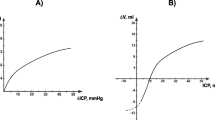Abstract
It is generally accepted that myogenic, metabolic and neurogenic regulation mechanisms exist for the cerebral blood flow (CBF). Recently, a hydraulic control acting at the predural level has been suggested by Chopp et al. [2] These mechanisms, however, do not take into consideration the problem represented by the peculiar feature of the brain (an incompressible organ) within the skull and dura mater (a rigid box and a stiff envelope), perfused by a pulsatile blood flow through a vascular tree with elastic walls. On the basis of this consideration we think that the progressive CBF reduction up to cerebral circulatory arrest following severe intracranial hypertension is probably due to an unbalance between cerebral blood volume variations during each cardiac cycle and the compensatory systems, primarily the venous vascular bed.
Access this chapter
Tax calculation will be finalised at checkout
Purchases are for personal use only
Preview
Unable to display preview. Download preview PDF.
Similar content being viewed by others
References
Anile C, Rinaldi A, Roselli R, Visocchi M, Ferraresi A, Serricchio M, Dal Lago A, Bradariolo S, Calimici R, Della Corte F, Maira G (1989) An experimental model of “brain tamponade”. Preliminary observations on ICP dynamics, carotid blood flow velocitimetry and EEG activity. In: Hoff JT, Betz AL (eds) Intracranial pressure VII. Springer, Berlin Heidelberg New York London Paris Tokyo Hong Kong, pp 941–943
Chopp M, Portnoy HD, Branch C (1983) Hydraulic model of the cerebrovascular bed: An aid to understanding the volume-pressure test. Neurosurgery 13:5–11
Hassler W, Steinmetz H, Pirschel J (1989) Transcranial Doppler study of intracranial circulatory arrest. J Neurosurg 71:195–201
Lindegaard K-F, Grip A, Nornes (1980) Precerebral haemodynamics in brain tamponade. Neurochirurgia 23:133–142
Van Eijndhoven JHM, Avezaat CJJ (1986) Cerebrospinal fluid pulse pressure and the pulsatile variation in cerebral blood volume: an experimental study in dogs. Neurosurgery 19:507–522
Author information
Authors and Affiliations
Editor information
Editors and Affiliations
Rights and permissions
Copyright information
© 1993 Springer-Verlag Berlin Heidelberg
About this paper
Cite this paper
Anile, C. et al. (1993). Biomechanical Regulation of Cerebral Blood Flow. In: Avezaat, C.J.J., van Eijndhoven, J.H.M., Maas, A.I.R., Tans, J.T.J. (eds) Intracranial Pressure VIII. Springer, Berlin, Heidelberg. https://doi.org/10.1007/978-3-642-77789-9_56
Download citation
DOI: https://doi.org/10.1007/978-3-642-77789-9_56
Publisher Name: Springer, Berlin, Heidelberg
Print ISBN: 978-3-642-77791-2
Online ISBN: 978-3-642-77789-9
eBook Packages: Springer Book Archive




